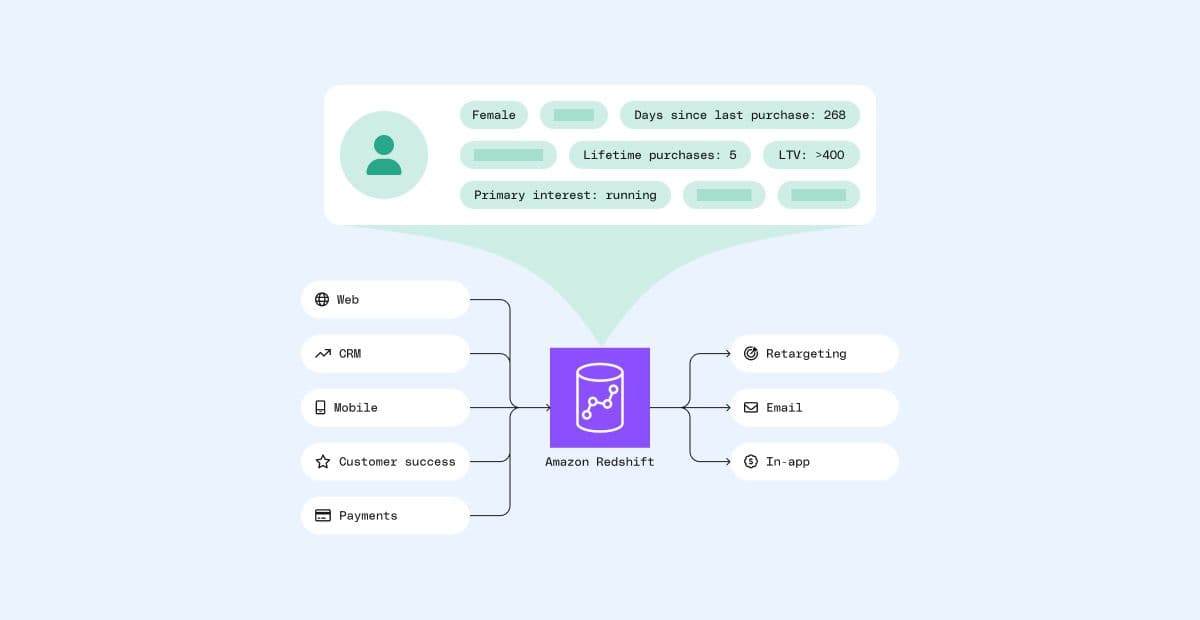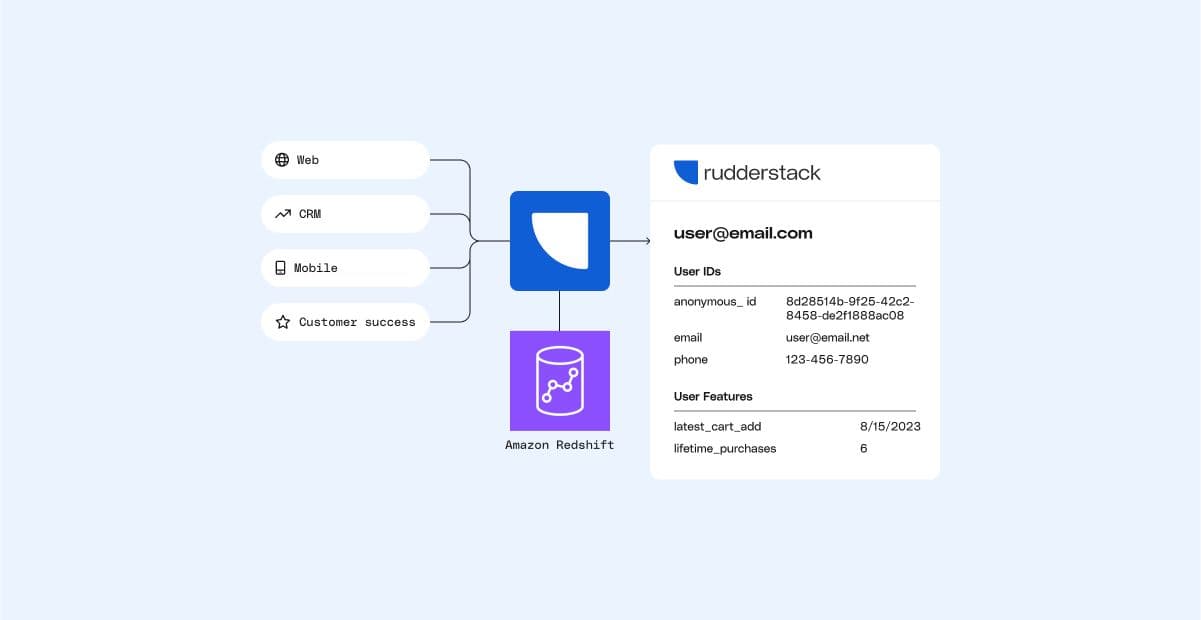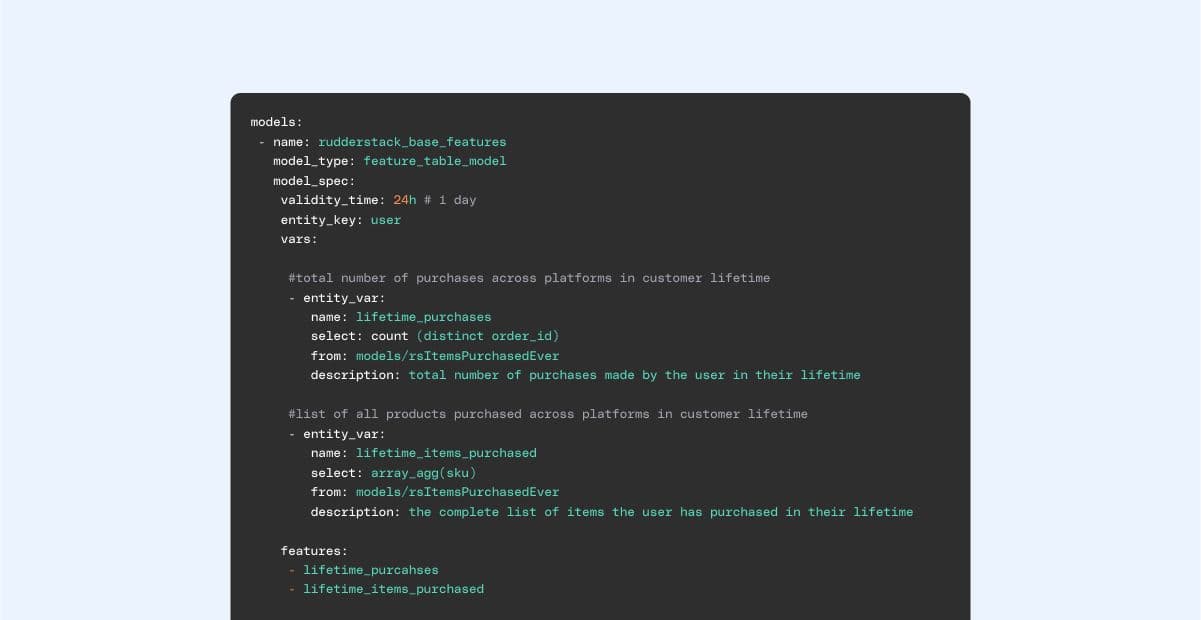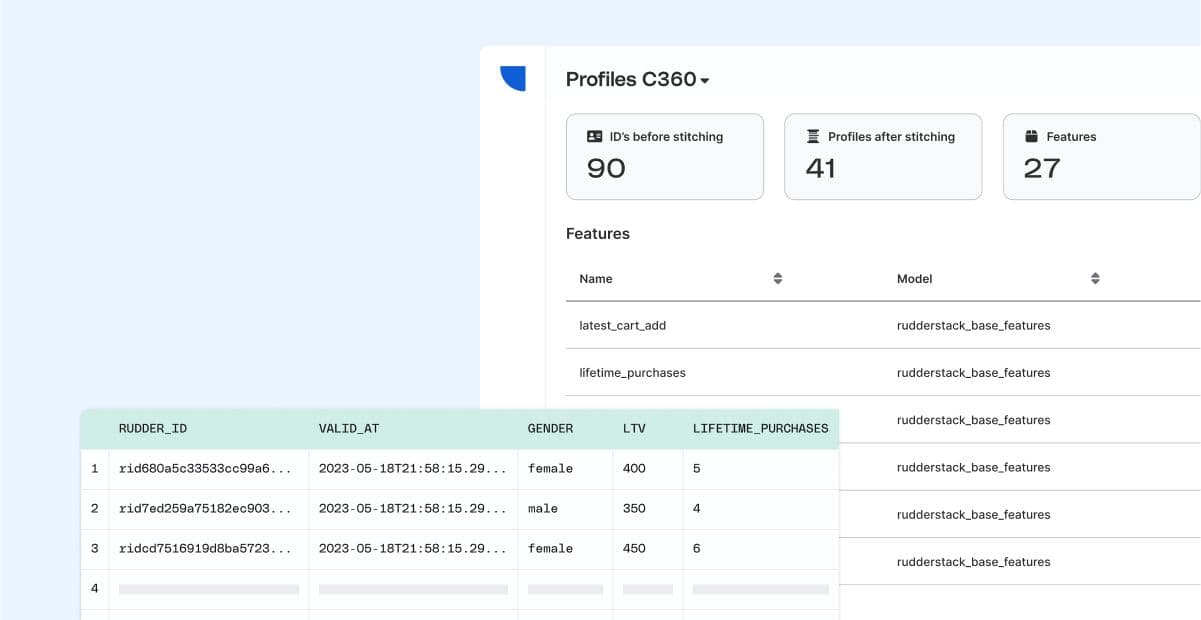Build your customer 360 in Amazon Redshift with RudderStack Profiles

When you create an actionable, accessible customer 360, you can build strong relationships with your customers at scale. The customer 360, or complete customer view, enables every team to work from a single source of truth with rich, up-to-date information about every customer in the tools they use every day. It makes it possible to deliver a cohesive, personalized, end-to-end customer experience that sets your brand apart and ultimately drives increased revenue.
Building a customer 360, however, involves a number of data challenges. To deliver a customer 360, you must collect data from every customer touchpoint, unify the data, and model it into activation-ready profiles. Then you must deliver these profiles to the teams and tools that can use them to drive better business outcomes.
This work involves complex data wrangling and has, historically, kept all but the most sophisticated companies from building and operationalizing a customer 360. That’s why we built RudderStack Profiles. With RudderStack Profiles and Amazon Redshift, data teams can now build a customer 360 directly in their data warehouse without the complex query and modeling work.
RudderStack Profiles enables every data team to deliver a customer 360
RudderStack Profiles is a data unification tool that makes it easy for you to build your customer 360 natively in your data warehouse.
Profiles declarative approach effectively eliminates low-level data unification work and automatically produces a customer 360 table in your data warehouse. Instead of relying on a black box SaaS tool for your customer 360 or writing excessive amounts of SQL, Profiles enables you to specify important customer traits, then it runs the joins and computations for you, automatically producing an identity graph, user features, and full customer 360 table in your warehouse.

Profiles supports customer 360 use cases for every team from machine learning to marketing and customer success by making it easier to deliver actionable customer profiles to over 200 business tools.
As part of our end-to-end warehouse native customer data platform, Profiles’ unification capabilities complement our tools for data collection and activation, so you can deliver value along the entire data activation lifecycle.
How RudderStack Profiles makes it easy to build your customer 360 in Amazon Redshift
Combining Amazon Redshift and RudderStack allows you to drive more value with your data warehouse investment. Redshift provides a secure, reliable, performant, and highly scalable warehousing solution, and our Warehouse Native Customer Data Platform eliminates the engineering challenges that come with data collection, unification, and activation. Here’s how RudderStack Profiles makes it easier for you to deliver value to the business with your customer data:
Deliver impact faster with out-of-the-box customer 360 assets
When you use our Event Stream pipeline to ingest user data into Amazon Redshift, the schemas, unique identifiers, and table relationships are already known. This allows Profiles to generate an identity graph and over 30 event-based user features out of the box.
All you have to do is specify the data sources and run a Profiles job using our Customer 360 template. Then, traits like days_since_last_seen, first_campaign_name, and active_days_in_last_7_days will immediately be available in Amazon Redshift.
These enriched data points can speed up analytics projects, and you can sync them to business tools through our Reverse ETL pipeline.

Configure identity graphs for any entity at any level of complexity
If you have multi-faceted identity resolution requirements, you need to model relationships between various customer or object entities using more than just event data. For example, you might have individual users who belong to multiple business accounts. You could have separate subscribers who all belong to a single household. You might even have to account for multiple connected IOT devices that belong to a single customer.
While modeling these relationships at scale can outstrip the capability of no-code tools, Profiles has no such limitations. With Profiles, you can use our robust UI, or you can customize identity models through our code-based Profile Builder that fits within your existing version-controlled development workflows.

Go beyond identity resolution and easily compute complex traits
To build a true 360-degree view of the customer, you have to complete the picture by combining known traits (like userId and email) with computed traits, like the number of days a user has been active and the average dollar amount of items in their most recent cart.
Profiles enables you to generate these data points without complex SQL. Just write simple metrics definitions, then Profiles will automatically compute the values natively in your warehouse and add them to the customer 360 table where you can use them for analytics and activation in business tools.

View the full customer journey with funnels and semantic events
Customer journeys happen sequentially over time, and they’re defined both by what users do and what they don’t do. But building funnels and modeling semantic events in SQL is notoriously difficult.
Profiles features templates that automatically generate common semantic events and funnels from RudderStack event data, immediately delivering analytics-ready data in Amazon Redshift. For more complex use cases, you can model the full customer journey using simple definitions and human-readable operators like “before” and “after” in version-controlled config files.
Automate metadata management
One of the most difficult parts of maintaining an identity graph and customer 360 table is the upkeep of a historical record of how data points change over time. This metadata, however, is critical for historical customer journey analysis, and it’s a key component of ML models used for use cases like churn prediction and product recommendations.
Profiles automates this metadata management entirely. It creates a snapshot table in Amazon Redshift every time a Profiles job is run, giving you full visibility into the time series changes of your customer profiles.
How StatPearls built a Warehouse Native CDP with RudderStack Profiles and Amazon Redshift
StatPearls is a leading healthcare education and technology company that serves educational content to medical professionals accross hundreds of different job roles. The company boasts the largest and most comprehensive e-Learning library in healthcare, with over 10,000 peer-reviewed PubMed-indexed articles on virtually every clinical topic in healthcare, 500 different exams, and thousands of single courses.
The typical StatPearls customer journey is incredibly complex and spans multiple ad platforms, sites, and applications. To better understand and optimize the customer experience, the team at StatPearls attempted to combine data from these various sources to understand how users found their site, which products new users purchased, which courses they completed, and how often they came back to purchase additional products.
Initially, they tried exporting data from payments systems and querying their app databases, but their lack of dedicated infrastructure for customer data meant that visibility was limited, data quality was low, and time to insight was prohibitively slow.
To solve this data divide, StatPearls chose RudderStack as its Warehouse Native CDP solution. StatPearls used our Event Stream pipeline to capture the entire customer journey and deliver it to Redshift, where they combined customer journey clickstream data with payments data from Stripe using our ETL pipeline.
With all of this data in Redshift, Statpearls took advantage of RudderStack Profiles to unify their data into a customer 360 table. Their efforts began paying off immediately. Since implementing Profiles, StatPearls has seen results across the business:
- The company now has a strong understanding of attribution and can accurately calculate lifetime value (LTV) across purchases and subscriptions.
- The paid advertising team increased their Google Ads budget 3.8x while maintaining positive, efficient ROAS because they can now combine granular attribution data with payment history to understand how much money they make from different types of customers and how much money they spent on the campaigns that drove conversion.
- The data and marketing teams collaborated to increase customer retention by 1.7x using machine learning models to predict churn so marketing can take action before they lose a customer.
“Understanding our audience was a great first step, but now we are starting to proactively shape the customer experience through predictive traits. We now send them really compelling emails or offers when we detect they are likely to churn.”
Read the full case study for more details on how the team at StatPearls is using RudderStack and Amazon Redshift to drive more value with their customer data.
Start building your Warehouse Native CDP today
With an actionable customer 360, you can leverage your customer data to build strong relationships with every customer at scale. RudderStack Profiles makes it easier for you to build a customer 360 natively in Amazon Redshift, so you can drive more value from your data warehouse investment. Request a demo to learn more about RudderStack Profiles and see it in action.
Build your customer 360 in your data warehouse
Schedule a demo with our team to learn more about RudderStack Profiles
Published:
November 28, 2023

Salesforce data enrichment: Best tools for 2025
Without proper enrichment, Salesforce customer records can become stale, incomplete, and increasingly disconnected from reality. Learn about the best tools for real-time syncing, identity resolution, and deep integration with modern data stacks.

Data matching techniques: Best practices & challenges
In this article, we’ll explore the core techniques behind data matching—such as identity resolution and record linkage—along with the common challenges teams face and the best practices for improving match quality at scale.

A groundbreaking approach to creating and delivering complete customer profiles
RudderStack Profiles introduces a groundbreaking approach to solving identity resolution. It enables every data team to power their business with reliable, complete customer profiles. In this blog, we show you how.







